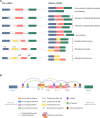Alternative RNA splicing in cancer: what about adult T-cell leukemia?
- PMID: 35979354
- PMCID: PMC9376482
- DOI: 10.3389/fimmu.2022.959382
Alternative RNA splicing in cancer: what about adult T-cell leukemia?
Abstract
Eukaryotic cells employ a broad range of mechanisms to regulate gene expression. Among others, mRNA alternative splicing is a key process. It consists of introns removal from an immature mRNA (pre-mRNA) via a transesterification reaction to create a mature mRNA molecule. Large-scale genomic studies have shown that in the human genome, almost 95% of protein-encoding genes go through alternative splicing and produce transcripts with different exons combinations (and sometimes retained introns), thus increasing the proteome diversity. Considering the importance of RNA regulation in cellular proliferation, survival, and differentiation, alterations in the alternative splicing pathway have been linked to several human cancers, including adult T-cell leukemia/lymphoma (ATL). ATL is an aggressive and fatal malignancy caused by the Human T-cell leukemia virus type 1 (HTLV-1). HTLV-1 genome encodes for two oncoproteins: Tax and HBZ, both playing significant roles in the transformation of infected cells and ATL onset. Here, we review current knowledge on alternative splicing and its link to cancers and reflect on how dysregulation of this pathway could participate in HTLV-1-induced cellular transformation and adult T-cell leukemia/lymphoma development.
Keywords: Alternative splicing; Chemoresistance; HTLV-1; Leukemia; Oncogenesis.
Copyright © 2022 Tram, Mesnard and Peloponese.
Conflict of interest statement
The authors declare that the research was conducted in the absence of any commercial or financial relationships that could be construed as a potential conflict of interest.
Figures



Similar articles
-
HTLV-I basic leucine zipper factor gene mRNA supports proliferation of adult T cell leukemia cells.Proc Natl Acad Sci U S A. 2006 Jan 17;103(3):720-5. doi: 10.1073/pnas.0507631103. Epub 2006 Jan 9. Proc Natl Acad Sci U S A. 2006. PMID: 16407133 Free PMC article.
-
Characteristic expression of HTLV-1 basic zipper factor (HBZ) transcripts in HTLV-1 provirus-positive cells.Retrovirology. 2008 Apr 22;5:34. doi: 10.1186/1742-4690-5-34. Retrovirology. 2008. PMID: 18426605 Free PMC article.
-
Adult T-cell leukemia-lymphoma as a viral disease: Subtypes based on viral aspects.Cancer Sci. 2021 May;112(5):1688-1694. doi: 10.1111/cas.14869. Epub 2021 Mar 30. Cancer Sci. 2021. PMID: 33630351 Free PMC article. Review.
-
The endogenous HBZ interactome in ATL leukemic cells reveals an unprecedented complexity of host interacting partners involved in RNA splicing.Front Immunol. 2022 Aug 1;13:939863. doi: 10.3389/fimmu.2022.939863. eCollection 2022. Front Immunol. 2022. PMID: 35979358 Free PMC article.
-
The Role of HBZ in HTLV-1-Induced Oncogenesis.Viruses. 2016 Feb 2;8(2):34. doi: 10.3390/v8020034. Viruses. 2016. PMID: 26848677 Free PMC article. Review.
Cited by
-
Xanthohumol as a potential therapeutic strategy for acute myeloid leukemia: Targeting the FLT3/SRPK1 signaling axis.J Food Drug Anal. 2025 Mar 31;33(1):31-47. doi: 10.38212/2224-6614.3534. J Food Drug Anal. 2025. PMID: 40202412 Free PMC article.
-
An immunoinformatics and extended molecular dynamics approach for designing a polyvalent vaccine against multiple strains of Human T-lymphotropic virus (HTLV).PLoS One. 2023 Sep 8;18(9):e0287416. doi: 10.1371/journal.pone.0287416. eCollection 2023. PLoS One. 2023. Retraction in: PLoS One. 2025 May 6;20(5):e0324071. doi: 10.1371/journal.pone.0324071. PMID: 37682972 Free PMC article. Retracted.
-
Murine leukemia virus (MLV) P50 protein induces cell transformation via transcriptional regulatory function.Retrovirology. 2023 Sep 12;20(1):16. doi: 10.1186/s12977-023-00631-w. Retrovirology. 2023. PMID: 37700325 Free PMC article.
References
Publication types
MeSH terms
Substances
LinkOut - more resources
Full Text Sources
Medical
Miscellaneous

